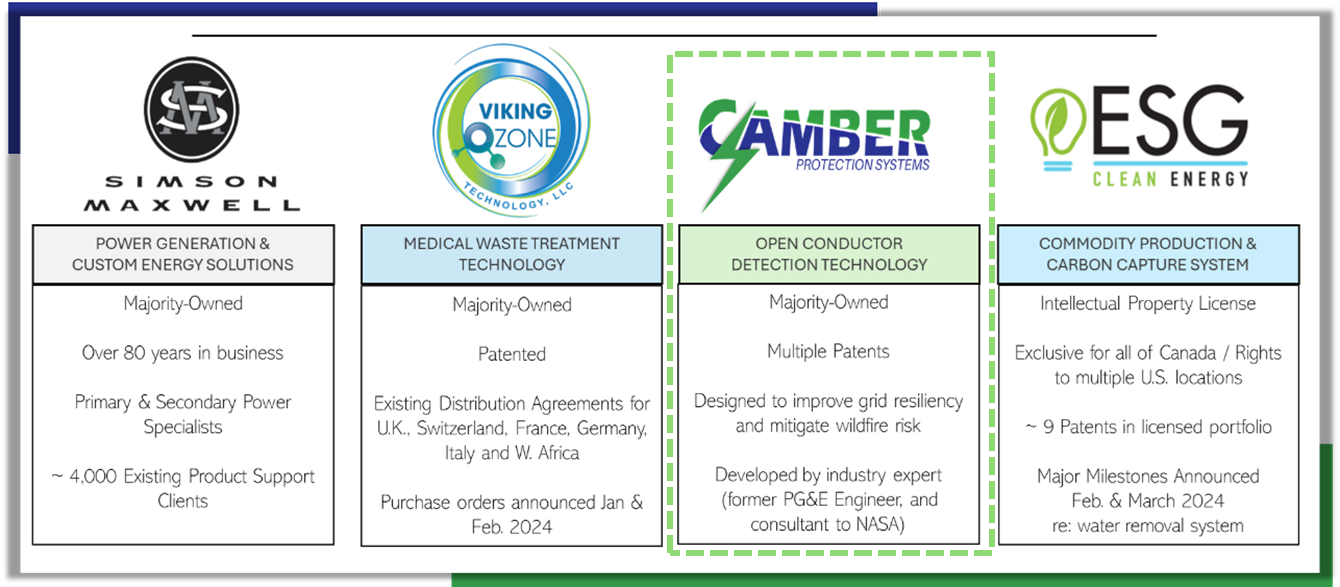Camber Energy Announces Issuance of Additional Patent Covering Transmission Line Ground Fault Prevent Systems
- None.
- None.
Insights
The issuance of U.S. patent 11,942,776 to Viking Protection Systems, LLC, under Camber Energy, Inc., signifies an advancement in energy infrastructure technology that could have substantial implications for the energy sector. This technology, aimed at mitigating wildfire risks and enhancing grid stability, addresses a critical need for improved safety measures in power transmission. Given the increasing frequency of wildfires and their impact on both human lives and utility companies' finances, this innovation might lead to a competitive advantage for Camber Energy.
From a financial perspective, the integration of such technology could potentially lead to cost savings from reduced fire-related damages and improved grid reliability. This could translate into lower insurance premiums and operational costs for utility companies, possibly improving their bottom line. Investors might view this patent as a positive development, potentially increasing Camber's market value and attractiveness to partnerships with utilities seeking to upgrade their infrastructure.
The granting of a patent by the USPTO is a critical step in protecting the intellectual property (IP) and creating barriers to entry for competitors. Camber's newly patented technology for Electric Transmission Line Ground Fault Prevention could be pivotal in safeguarding its market share and securing licensing deals. The exclusivity provided by the patent enables Camber to control the use of the technology, which could lead to significant revenue generation through licensing agreements with other companies in the energy sector.
It's essential to note that the strength of a patent lies in its enforceability and the breadth of its claims. As such, the long-term financial impact on Camber will depend on its ability to defend the patent against infringement and its success in commercializing the technology. If the technology becomes widely adopted, Camber could benefit from a steady stream of royalty income, enhancing shareholder value.
The introduction of Broken Conductor Protection technologies by Camber Energy speaks to a growing trend of environmental and social governance (ESG) considerations in business operations. The potential for this technology to prevent wildfires and improve public safety is a significant step forward in addressing environmental concerns associated with the energy sector. Utility companies incorporating such technologies could see an improvement in their ESG ratings, which is increasingly important to socially conscious investors.
Moreover, the ability to de-energize power lines swiftly in the event of a fault could lead to a reduction in the environmental devastation caused by wildfires, which has been a point of contention for communities and regulators alike. This could improve Camber's reputation and stakeholder relations, potentially leading to supportive regulatory policies and community backing for their projects. The long-term benefits could include a stronger brand and customer loyalty, which are intangible assets that contribute to a company's sustainability and profitability.
I.P. is Part of Solution Designed to Mitigate Wildfire Risk and Improve Grid Stability
HOUSTON, TX / ACCESSWIRE / March 28, 2024 / Camber Energy, Inc. (NYSE American:CEI) ("Camber" or the "Company"), today announced that on March 26, 2024, the U.S. Patent and Trademark Office (USPTO) issued U.S. patent11,942,776 entitled "Electric Transmission Line Ground Fault Prevention Systems Using Dual Parameter Monitoring With High Sensitivity Relay Devices in Parallel With Low Sensitivity Relay Devices".
This new patent is part of a portfolio of intellectual property that has been incorporated into Broken Conductor Protection technologies:
- designed to detect a broken conductor anywhere on a transmission circuit and de-energize the line within half of a second before it touches the ground or a grounded structure;
- which do not interfere with existing protection;
- work on all transmission circuits in conjunction with existing equipment;
- are more reliable than other solutions because they leverage the physics of a transmission circuit; and
- designed to prevent broken conductors from starting fires and/or injuring persons.
- The technology is designed to be an integral component within a much-needed, worldwide grid hardening and stability initiative by electric utilities to improve resiliency and reliability of existing infrastructure.
The new patent was issued to Viking Protection Systems, LLC, a majority-owned subsidiary of Camber's wholly-owned subsidiary, Viking Energy Group, Inc.
About Camber Energy, Inc.
Camber Energy, Inc. is a growth-oriented diversified energy company. Through its wholly-owned subsidiary, Viking Energy Group, Inc., Camber: (i) provides custom energy & power solutions to commercial and industrial clients in North America; (ii) holds an exclusive license in Canada to a patented carbon-capture system; and (iii) has a majority interest in: (a) an entity with intellectual property rights to a fully developed, patented, ready-for-market proprietary Medical & Bio-Hazard Waste Treatment system using Ozone Technology; and (b) entities with the intellectual property rights to fully developed, patent pending, ready-for-market proprietary Electric Transmission and Distribution Open Conductor Detection Systems. For more information, please visit the company's website at www.camber.energy.

Forward-Looking Statements
This press release may contain forward-looking information within the meaning of Section 21E of the Securities Exchange Act of 1934, as amended, and Section 27A of the Securities Act of 1933, as amended. Any statements that are not historical facts contained in this press release are "forward-looking statements", which statements may be identified by words such as "expects," "plans," "projects," "will," "may," "anticipates," "believes," "should," "intends," "estimates," and other words of similar meaning. Such forward-looking statements are based on current expectations, involve known and unknown risks, a reliance on third parties for information, transactions that may be cancelled, and other factors that may cause our actual results, performance or achievements, or developments in our industry, to differ materially from the anticipated results, performance or achievements expressed or implied by such forward-looking statements. Factors that could cause actual results to differ materially from anticipated results include risks and uncertainties related to the fluctuation of global economic conditions or economic conditions with respect to the oil and gas industry, the COVID-19 pandemic, the performance of management, actions of government regulators, vendors, and suppliers, our cash flows and ability to obtain financing, competition, general economic conditions and other factors that are detailed in Camber's filings with the Securities and Exchange Commission. We intend that all forward-looking statements be subject to the Safe Harbor Provisions of the Private Securities Litigation Reform Act of 1995.
Camber cautions that the foregoing list of important factors is not complete, any forward-looking statement speaks only as of the date on which such statement is made, and Camber does not undertake to update any forward-looking statements that it may make, whether as a result of new information, future events or otherwise, except as required by applicable law. All subsequent written and oral forward-looking statements attributable to Camber or any person acting its behalf are expressly qualified in their entirety by the cautionary statements referenced above.
Contact Information
Investors and Media:
Tel. 281.404.4387
SOURCE: Camber Energy, Inc.
View the original press release on accesswire.com







